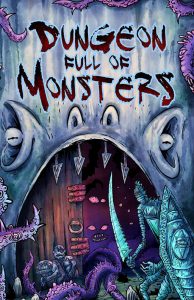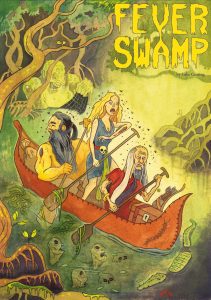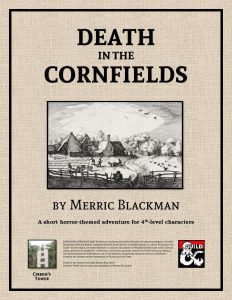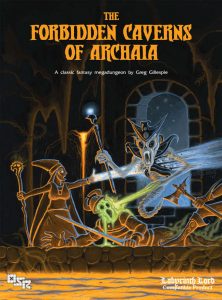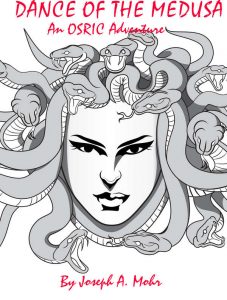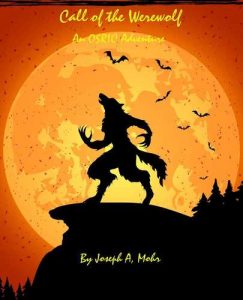This will be long. I beg your understanding for my verbosity hypocrisy; this is the product of four years work.
I have now reviewed every adventure in every print issue of Dungeon Magazine. I started in August of 2013, after spending several months locating issues. It was a herculean effort and, several times, it broke me. You have no idea what it’s like to wake up every day and “look forward” to another issue of Dungeon. Or maybe you do. It was hell.
I say “every adventure”, but there were exceptions. I didn’t review solo adventures or significant genre deviations, like Marvel Super Heroes. I did every fantasy adventure and most of the sci-fi ones. I generally reviewed them Wednesday, Thursday, and Fridays, taking notes and then writing the review on Saturday for posting the next Saturday morning on my review website tenfootpole.org.
On my site I generally review OSR adventures, with a few 5e/Pathfinder and other deviations. I’m a fan of the new old school adventures and think the best are much better than the original adventures. I prefer a rules-light approach to D&D and have a fondness for things with folklore elements, fey, barrows, gonzo, and urban adventures … which I usually try to disclose. I’ve reviewed about 1400 D&D/fantasy adventures so far as of October 2017.
I have review standards and strong beliefs on what makes a good adventure. First and foremost it has to be useful to the DM at the table while they running it. This is the primary purpose of every adventure ever written, even if the designer didn’t understand that fact. You can use it as inspiration, steal parts from it, or use it as a doorstop if you want, but, judged as an adventure, it has to be useful at the table. My standards are VERY high.
A large part of being useful at the table is a writing style that allows the DM to scan the text quickly during play and locate information. The characters walk in to a room and the DM must quickly, in just seconds, locate the description, grok it, and relate it to the players. Then as they react the DM must continue scanning and absorbing to react to their actions as guided by the DM text for the room. This almost always means a terse and evocative writing style that’s well organized. After this, we come to creativity, interesting encounters, and all the rest. It can’t be boring. But first, it has to be useful to the DM at the table.
Dungeon Magazine is an abject failure in this regard. It is VERBOSE. Mountains of backstory, mountains of room text. All of it fights the DM running it at the table. If you are including something in the main text then it has to be directly useful for play. If it’s not then it needs to be removed or moved to an appendix where it can be ignored. Dungeon Magazine didn’t do this. It reveled in useless detail. A LONG room description that describes a trophy room, all of the trophies and accomplishments, and then ends “but it was long ago looted and now nothing remains but dust.” Backstory, history, detail that doesn’t apply to play, a verbose writing style … these were the hallmarks of most Dungeon Magazine adventures.
I’ve often pondered why they were so verbose. I’ve settled on the evils of Pay Per Word, that encouraging extra text. I’m not sure of the editing policies, but it would also seem valid to point to a weakness there in the quality of the published material. At some point I may follow up with the editors; I’m curious. I also empathize with their jobs, having to wade through garbage day after day. While my task was voluntary they had the extra pressure of mortgages and kids to raise.
As far as genres, the Oriental Adventures pieces were generally good, especially the earlier ones. They did a great job of capturing a high folklore environment that felt different than standard D&D. I can’t comment on their accuracy vs asian mythology and folklore, or their cultural issues, I don’t know enough. But as folklore-heavy adventure with talking animals and relatable situations then they score high.
The Adventure Paths in Dungeon Magazine were generally dreadful. The Mere of Deadmen series, a proto-adventure path, had a couple of decent ideas and adventures before becoming mired in boringness. The “real” adventure paths have two age-old problems that have yet to be solved: plot & high-levels. I generally found the first couple of adventures in the series interesting, and an occasional idea in later issues. The trek through the jungle after a shipwreck in Tides had some nice set pieces. There was also a great diplomacy idea with demon lords in the same series. D&D does a great job at low levels and high-level adventures have yet to be figured out. Too much gimping of the characters abilities to force them in to what is, essentially, a low level adventure design. Or, just as bad, resorting to defining high-level as “tougher monsters.” The need to drive players through the plot turns the things in to a railroad.
Ah, the linear adventure. Usually with set pieces. When it comes to Combat as War vs Combat as Sport, I’m very much in the War category. Linear adventures, rules mastery, balanced combats … these are not the D&D elements I enjoy. I don’t understand it. The long stat blocks and attempts to build reason in to a dungeon via rules … A magic mouth says a key word that dispels a contingency that holds a stasis that summons a monster. You’re the DM. You can do anything, the rules don’t apply. I can’t imagine how anyone prefers this style. TOlerates maybe, but prefer?
The early adventures tend to be more creative and have more elements to steal. As the issues count up, especially after issue 100, the designs become more linear and more focused on stat blocks. It’s also the case that some famous designers, like Baur, did great work in Dungeon … compared to their modern work.
The Best Dungeon Magazine Adventures
After going through all of the issues reviews I’ve come up with a list of adventures that I think don’t suck. Some are even good. In a stunning coincidence, it has come out to ten. It just turned out that way. Most of these have never shown up on a “best” list before, although a couple will have had a person or two reccomend them in the various “what adventures in Dungeon are good?” forum threads. Thelist will also show the depths of my hypocrisy. In no particular order …
The Spottle Parlor – Levels 2-4, Issue #12, Rick Swan
This is a whimsical little adventure with some strong NPC’s. As a result you get a very nice little evening of gaming driven by the interactions of the NPC’s. It’s really exactly the kind of whimsical feel with strong themes and strong classical archetypes that I groove on. A rich old crippled guy, a well known gambler, invites the group to gamble that evening. They arrive to find a fat cleric, a dumb kid, and a hissing lizard man all sitting around the table. What results is some prelude scene setting and then ten rounds of gaming. It’s characterized by the priest begging for donations for his temple … which he then generally gambles away. The dumb kid has to have EVERYTHING explained to him. The lizard man thinks someone is giving him the evil eye. And the gambler doesn’t seem to care that he’s losing. Then the hobgoblins show for the slaves they pressured the gambler in to. It’s got a long intro but the vibe here is really great and the writing communicates the feel of the NPC’s and the feel of the adventure VERY well. For example, the priest is very high strung and nervous, more so lately because he has only been able to solicit 9cp in a week of trying to raise funds, as charged by his superiors, for a new holy shrine. There’s 11 or 12 ’rounds’ of conversation given, which I all found delightful. There’s even a little section at the end on salvaging the adventure if the PC’s knock it off the rails. The designer is one of the PO’s responsible for one of, if not the, worst product of all time: WG7 Castle Greyhawk. With this adventure he slightly redeems himself.
The Ruins of Nol-Daer – Levels 5-8, Issue #13, Howard McClesky
It’s a three level abandoned/ruined keep now inhabited by a motley assortment of creatures that … and get this … all make sense together. I don’t mean they are fire giants with hell hounds or some such. There is a wide variety of creatures here and their reason for being here, working together or not, seems … realistic? There’s a page or so of bullshit introduction/background that is completely worthless but once past it you get a decently tight adventure, at least for the time it was written in. It’s got some great hooks that are short and yet integrate well in to the adventure. In fact, that’s a good summary. The adventure is full of things that are NOT throw away and fit in well. It has a certain internal logic. The ruined keep has impacted the countryside and there are a variety of places around it that have suffered. Missing livestock, a mining camp having trouble, bandits having trouble when making camp … these backgrounds, rumors, and real events all fit in very naturally. The adventure proper has a great map of a ruined keep and the encounters are full of real gamble material. A tumble down courtyard has a description that centers around the impact of it being tumble down. A monster hides in a room astral projecting … just go ahead and kill it. There’s a NICE magic ring that talks to the party and tries to get them to take it with them. Each of the encounters center around not just some bullshit victorian cataloging of the room contents but in how the players can interact with it or in how he DM can use it to interact with the players. Arrow slits might have things behind them, etc. that the DM can use to increase the players paranoia. That kind of practical advice to use in actually running the game is what sets this apart from the vast majority of dreck.
Ancient Blood – Levels 3-5, Issue #20, Dave Boucher
This one just barely squeeks in. This is an arctic overland expedition followed by the exploration of an old giant fortress. It’s got a strong norse feel to it. The players are hired to deliver a box of dried plants (herbal medicine) to a village about 200 miles away. Once there they see the headman/king get killed by a frost giant ghost. They then travel 300 more miles, hopefully, through arctic conditions to get to an old frost giant fortress to break the ghosts curse. There’s a whole “wilderness survival guide”/”torture the players with bookkeeping for rations, etc” thing going on that I don’t think adds any fun to the adventure at all. I can go to work if I want to find the crossover point to carrying rations/winter supplies to travel speeds. I’ve played Source of the Nile and it isn’t fun. The journey to the village has a nice little wandering monster table that adds some encounter notes/suggestions next to each entry. I like that sort of thing. it prompts the DM to riff off of it and loads their imagination up to run the adventure. Tribesmen are from one of the villages and may travel with the party back. Animals act like animals. These little notes add a lot to the adventure. The programmed encounters, two, are nice also. The party passes by a steaming crack in the ground … who wants to go look! Just that visual imagery of seeing that after a snow adventure is enough to sucker me in. There’s also a nice little encounter with a group of half-ogre trappers. It’s written more like a straight up combat, even though they each get names and some description that would imply there can be a social element. The social path would be much cooler and interesting. The village the group reaches has a nice little “get there in a blizzard and be ushered in to the great house to get stranger out of the storm” thing going on which, again, I think builds a lot of cool things up in my mind as I’m reading, which in turn allows me to communicate the scene and feel better to the party. There’s a page-long read-aloud in the longhouse that night that ends with a railroaded killing of the chief. That’s less cool, but I understand why its there. The group then travels to an old fortress and explores it. Both the journey, a shield-wall, and the fortress proper is full of GREAT imagery. Blood fountains, centuries old sacrifices hung out, and other great little staged scenes. It does have a very ‘desolate beauty’ thing going on, similar to the snowy cabin/forest in Legend, but much better done, with crunchy snow drifts, giants tables, and eerie silence everywhere. It’s got a kind of quiet horror thing going on that only an abandoned and silent place in the snow can deliver, combined with the weird proportions brought by giant sized tables and rooms. A nice nordic gothic feel, if there is such a thing. It’s a little slow for my tastes but beefing it up would ruin the slow burn. If someone can figure out how to solve that paradox then this would be worth running, if the “wilderness torture” game problem could also be solved.
Incident at Strathern Point – Levels 8-10, Issue #21, Matthew Maaske
This is an adventure at an abandoned river trading station, that turns out to have some demons in residence. It’s got a nice realistic looking map and a grim and gritty feel. The demons, four of them, are well described with lots of variation to their features. The layout of the station has lots of interesting features to get in to trouble with: a barrel ramp, rough cut steps outside, a couple of towers to fall of of, and a barge to end up on. I really like this, you can just imagine PC’s getting trapped in a tower, leaping off of it, being assaulted by barrels, and slipping on the rough stairs as they run. The variety of terrain and features in the map bring a nice little tactical feel to it while still feeling VERY realistic of a river trading station. More so than most of the adventures, this one feels real, hence the grim and gritty vibe. It deals with death, trauma, demons, domestic abuse, and revenge in a really good way. This FEELS like a demon-haunted adventure. It’s wordy and the treasure count seems low to me, but it delivers. It would work well in either Harn or 2E, which I think speaks well to its design. The best encounters kind of stick with you. You read them one, maybe twice, and they are completely internalized. You need not hardly refer to the encounters again during play, it’s like you wrote it yourself. This entire adventure is like that. Read it once, maybe twice, and just run it with the map and maybe some creature stats. That’s all you need.
Mightier than the Sword – Levels 1-4, Issue #29, Willie Walsh
This adventure is absurd, in every wonderful sense of that word. You know how good it is? I LOVED THE BACKSTORY! I HATE long backstories, but I LOVED this one. One of the things I like about D&D adventures is when the players come up with crazy ideas on how to do something and we get to watch the comedy/tragedy that unfolds as they implement their zany plan. In the same genre is the adventure where the characters are the straight men. There’s some kind of zaniness going on around the characters and the players are trying to wade through it all. This is, probably, one of the few ways to do humor in D&D, and I LOVE IT. Everything in this adventure is completely plausible and makes sense. And when you take it as a whole, as an outsider, you’ll be left saying: What the FUCK is going on here? Are you people INSANE?! This is a faction adventure. And therefore an adventure with NPC’s . These are very good things to have in an adventure. The players and their characters will always interact with the world around them, especially in a village adventure like this, and having strongly imagined NPC’s goes a VERY long way to brining an adventure to life.
[Pontification OFF]
In a small town one of the scribes has invented … a metal nib for the end of a quill. The guild of scribes now hates him. The ink makers love him. The Goose Breeders Association hates him. The paper manufacturers are in both camps. The druids hate him. Essentially, everyone in this small town has an opinion, entirely plausible. And then the scribe turns up dead. The council, divided in to the two camps, seeks an independent prosecutor to investigate. Oh, and there’s a Committee on Public Recriminations running around also. And in to this quite plausible and quite absurd set up the party is tossed. And it’s wonderful. There are mobs laying wreaths and jumping to conclusions, the competent, the incompetent, random wanderers … in fact, lets talk about the wanderers. There’s a small overland adventure to get to the village. The party is accompanied by the messenger who delivered to them the offer. Except there are two, one from each faction, and they hate each other and compete to see who’s better and yet won’t go so far as to kill each other. It’s brilliant! And then the wanderers come in to play. There are 8 or so of these and each has a little set up to riff off of. One is with a normal hedgehog. If asked, via a Speak spell, he comes down completely neutral on the issue of the quill nibs, as long as hedgehog quills are not in consideration. THIS IS BRILLIANT. EVERYONE should have an opinion! (Not all do, but as the DM I’ll sure as fuck riff on that one things and turn EVERYONE in to having an opinion!!!) This thing suffers a bit from ’the style at the time’ issues. A summary of NPC’s would have been useful and some of the text gets a bit long. But, the adventure is GOLD! If you need to suffer through one old adventure with too much text this year then THIS is the one. Walsh was a prolific contributor to Dungeon and, more often than not, his adventures had something decent in them.
Thiondar’s Legacy – Levels 8-12, Issue#30, Steven Kurtz
This thing could almost be a completely stand-along product. Look, I’m about to talk smack about this, because it deserves it, but at the core of this is Something Good. You need to decide if its worth salvaging. I think it is. In fact, I don’t even think the salvage job is that severe. I would suggest, however, that you work this adventure in. You need to start dropping hints LONG before the players hit this thing. The College, the legends, etc. This is going to work best when it’s NOT dropped in out of the blue.
The backstory here is LONG. I mean REALLY long. You know the Unseen University, in Discworld? There’s a magi college with that kind of vibe. There’s a kind of power struggle and one of the magi, to be a dick, exercises his Right of Inventory. One every hundred years he can force an Grand Inventory to be done, which everyone hates because it’s a pain in the ass. In it, they find a magic shield with something unusual about it, which leads then to hire adventurers. That’s backstory one. Backstory two is about the guy who owned the shield. Backstory three is about the guy who the guy that owned the shield was trying to find. Way WAY too much backstory … but … more than enough also for you to slip in to your campaign, and, overtime, build these three places/people up. It would be like Obama, Putin, and Thatcher showed up one day, told you the illuminati were real, they were in it, King Arthur was real (like, not some pict/roman dude, but like really real, all the legends are real!), as was excalibur, and, oh yeah, we think we know where he’s buried. Could you go check it out? Yeah, you can keep the sword. Holy Shit!
There’s a valley adventure that’s … Good! Giant sheep on the hillsides! A misty steamy valley with a river in it! Stone Giants … who are not dicks! They talk to you! Hey have a captured bard playing music for them! You move on, to the dungeon, on a raft. And then something really cool happens. There’s this concept in the OSR of the dungeon as the Mythic Underworld. An important part of this is that the entrance MUST be significant. Or, maybe, that it has to feel like crossing the threshold is significant. This does that. You’re poling your raft down this river, across a lake and discover … a large stone arch that the water flows through. This is it. This is the place you’re looking for. As is so often the case, my own words can’t describe the brilliant SIMPLE imagery that is conveyed. But it works. You are not in the realm of THE OTHER. You poke around, find some signs that others are here, and then get TOTALLY fucked over by the king of the mushrooms. Who isn’t. I usually don’t care about spoilers, but this time I’ll be nice. There’s a hole intelligent set up here when you meet the mushroom king that leads to some great roleplaying. It’s social, or can be. And I LOVE it. You move on to find an eternal warrior you can put to rest. And then on to a HUGE steamy jungle cavern. And then on to a tower. It’s like it never stops! And there’s are NPC’s hanging around! REAL people with real problems and real emotions and they are wonderful and they are dicks and are complex but you can grasp them easily and run them well.
You know Dungeon published a couple of adventures with that stupid red dragon, Scorch of whatever he was called. They were supposed to be EPIC and Mighty and Majestic. They tried too hard and they sucked. This one though, this one FEELS epic. You feel immersed in it and you feel like something awesome is going on and that you’re a part of it and most importantly that you are DOING things and making a difference. I can’t recall, just now, another adventure that has given me this EPIC level feel. Ever.
You’re gonna need to take a read-through this before you run it, but I don’t think you’ll need to do much more to run it. For all of it’s text and wordiness, as was the style at the time, the ideas cement themselves in to your head. Dave Bowman write a wordy encounter with an old hill giant who likes to eat crab legs. Old Bae. It was quite long, for Bowman. The core of what it is is still fresh in my mind as if I had just read it. This adventure is like that one encounter: it stays with you. I think that’s pretty much the definition of Well Written.
Dovedale – Levels 1-3, Issue #46, Ted James & Thomas Zuvich
Danger! Folklore! Danger! I Love this stuff to an unnatural degree! The village stream has run dry, causing the villagers crops to have issues. They want you to fix it. The cause of the problems is a small band of goblins who have captured the stream’s source, a nixie, in order for the chief to better catch a giant talking fish. You see, he’s an avid fisherman. One of the rumors says a local ran across him one afternoon and they chatted while both fished and shared a beer.
OMG! I LUV this shit. A talking fish, a talking owl, and a talking giant rat are a part of the adventure; the local ‘kings’ of the animals. The goblin chief being an avid fisherman is great … as is the STUNNING gold and ruby fly he is tying in his fly vice to help him catch the talking fish. The goblins are old style. Stinkfoot (who has stinky feet), Swoop (who rides a giant bat), fishbelly (who can swim) and so on. One of them resembles a local boy and likes to go into the village and play pranks, and the local boy gets in trouble instead of him. It’s laid out well (especially considering the year), has a decent number of NPC’s, and the text is relatively terse and evocative. It’s the OLD folklore goblins rather than the generic sword-bair goblins that D&D usually presents. This adventure gets a hearty Thumbs Up from me …. uh … I’m not sure … this may be the first one in Dungeon I’ve ever done that for, without reservations?
Anyway, you have no soul if you don’t like this. I’m just saying. You suck if you don’t like this. You don’t want to suck, do you?
Peer Amid the Waters – Levels 1-2, Issue #78, Johnathan Richards
WoW! This is a good adventure! And I don’t even mean it on the “by Dungeon Magazine standards” grading curve! It’s actually good! I’m serious! Ready? I’m totally serious here, it’s good EVEN CONSIDERING WHAT I AM ABOUT TO WRITE. First, keep in mind it’s for level 1’s. And has what feels like an endless and boring backstory. And a hook that feels like it’s about 10 pages long … all to keep the party from killing some asshat nixies. And then consider it’s underwater. And has two mummies. (got magic weapons?) And an undead leopard. (more magic weapons needed!) And all of the room descriptions are like half a page long and full of shit no one cares about. AND ITS GOOD! I know! Level 1? Underwater? Ha! A million loaned things for the arty, right? Right? No! Nixie kisses! It’s wonderful! All is right in the world, it fits perfectly! And an egyptian tomb to explore? (a teleport circle opened a portal underwater to the tomb.) Lame … except … it’s an alien environment,, and totally bizarre to find out of nowhere! Mystery! Wonder! And combined with the already alien environment of underwater, it works great! And the DM Torture Porn of Underwater Adventuring is toned down to be just the good parts that are fun and enhance the adventure! How is that? Light sources halved … so the descriptions play on that … shadows and chaos suddenly appearing in your (very) restrictive magic 10’ light circle! And not immediately attacking you! Lungs full of water and can’t cast? How about an air pocket under an overturned boat? Or a glob of air stuck to a diving beetle? Perfect! Mummies? That’s easy! The folks who you are in search of almost killed it AND it’s got a CLEARLY magic sword sticking out of its back while it’s engaged in a fight with the diving beetle! The undead kitty is torn between protecting the tomb and curling up n a ball every round, because it’s a cat in water! Treasure chamber problems? The party has enough time to grab some loot before the teleport circle starts to disappear! This things MASTERFUL in it’s design It exploits the FUN inherent in the situations. I LOVE it when I expect something to suck ass and it turns out wonderful! WAAAYYYYYYY too much text in this, but fuck it. Get a highlighter and go to town! All Hail Discordia!
Depths of Rage – Level 3, Issue #83, JD Walker
This was a favorite of mine when it was originally published. I think it has stood up.
A week ago the local DCC mob went all funnel up in the local goblin caves … and no one came out as first level … or came back at all. Full of old people, women, and children, the party is encouraged to take a shot … and lured by a magic sword the goblin leader has. This intro is pretty abstract in the adventure and could use just a bit more colour.
The caves are multi-level, with bridges, chasms, chimneys, multiple ledges, cramped corridors, short 5’ ceilings full of smoke from torches, and other cave features. And then suddenly some crazed goblins come screaming out the darkness! There’s some nonsense about how they are barbarians, but it’s TOTALLY that cave scene in 13th Warrior (and fuck you if you don’t like 13th warrior! It’s one of the two best D&D movies EVAR!) Primitive cannibal goblins, fetishes all over the place shoved in the cracks & crevices, war paint, howling goblins, tight and evocative setting. I fucking love this cave! And THEN the place changes. After killing the leader there’s an earthquake the caves change, with new challenges to overcome! There’s even some faction play thrown in, with the bitter shamen being discovered (maybe) early on, and he’s willing to sell out the chief, as well as an NPC ranger. The read-aloud, while not imaginative, is mercifully short. The DM text, while not terse by my standards, is not the usual completely over-prescriptive text usually found in Dungeon, except maybe in its description of the cave features, which goes on for two pages. The reaction section, to the parties intrusion, could also be beefed up a little. A gross shamen bowl full of blood that’s Bulls Strength? Sign me up! I WAS disappointed that the magic sword is only a +2 longsword. 🙁 LAME!
Shut-In – Level 2, Issue #128, F. Wesley Schneider & James L. Sutter
Danger: I LUV a good urban adventure. This is a DELIGHTFUL adventure! It’s a little mystery/guard mission in an old lady’s house and is about 20 times more Ravenloft than almost all of the Ravenloft adventures. The Swan Street Slicer has escaped! On the way to jail, the mute halfling’s jail wagon was in an accident and he’s escaped! The guard is frantic, as is the entire town! Extra guards are everywhere! The party (hired? Hastily deputized?) is given the task of guarding the house of an old lady, her family having been one of the last victims. This is a nice hook. Hysteria in the city is fun, and its a good pretext as to why the guardsmen aren’t doing the guarding. They ARE, but EVERYONE/PLACE needs guards. It’s all hands on deck! So the party is in the old lady’s house, guarding it/her and her daughter. The NPC’s in this are wonderful. A bitter old woman in a wheelchair. Her lovely daughter, no longer engaged since her fiance was murdered by the slicer. A halfing butler who is best described as ‘simple.’ Strong NPC personalities to interact with. Then there are the people who come to visit, PERFECTLY described. “Nina’s dim-witted but good-natured nephew.” or “a greasy but ambitious banker” and so on. In one fucking sentence for each NPC this adventure does what so many others can’t seem to do: focus on the NPC description on interactivity. Who the fuck cares what your special snowflakes eye color is? What we need to know is how to play them when the party comes to interact. There’s a great little table included for the old woman and her daugher on how the parties interactions with them will impact their attitudes/diplomacy checks. And, even better, the table notes WHERE YOU CAN FIND THINGS! Giving the daughter some letters from her dead fiance will give you some positive modifier, but the table also tells you that they are in room six! Oh the humanity! A writer who actually makes things easier for the DM! The NPC’s, the house, what’s actually going on, the window dressing, t all contributes to a wonderfully creepy vibe. As time passes the party will do that thing that brings joy to the hearts of players and DM’s. They’ll say something like “Ohhh! It’s her! I know it’s her! Ohhh! I know it!” This sort of build up, starting out slightly irregular and building until the party snap in to action, is wonderful. “Telegraphed” isn’t quite the right word, but the mix of horror, with the … levity? Anticipation? From the players is great. The maps are way too small, and you’re going to STILL need a highlighter for the rooms. They are shorter than usual for Dungeon, but still need a bit of help.
Other Decent Adventures
I wrote six articles, each covering 25 issues, summarizing the adventures I thought were decent or had something interesting about them. Frankly, I think they are far weaker than the good modern OSR adventures (a list of which I keep on tenfootpole.org) but, if you’re looking to explore Dungeon Magazine then these would be a good place to start. The summary lists an be found at:
https://tenfootpole.org/ironspike/?cat=5
Other Best Of Lists & Special Merit
Kingdom of Ghouls, Issue #70, is generally much loved. Ghouls is quite lengthy but presents a weird world that is fully realized and coherent. It’s quite good, but generally makes a lot of Best Of lists so I didn’t include it in mine. It’s part of how Baur made his reputation and stands in stark contrast to his more recent works. Ssscaly Thingsss, in the same issues, is pretty good also.
Mud Sorcerer’s Tomb, from Issue #37, is also a favorite of many folks. In the same category as “Tomb of Horrors” but MUCH less arbitrary. ToH spawned a thousand terrible imitators and taught many people the wrong way to design/run a dungeon. If they had instead imitated Mud Sorcorer then the sun would be shining a little brighter. AGain, it’s not on my list because it’s on EVERYONE’s list.
There’s a decent List of Lists at Nerdvore:
http://www.nerdovore.com/2016/12/the-best-dungeon-magazine-adventure.html


